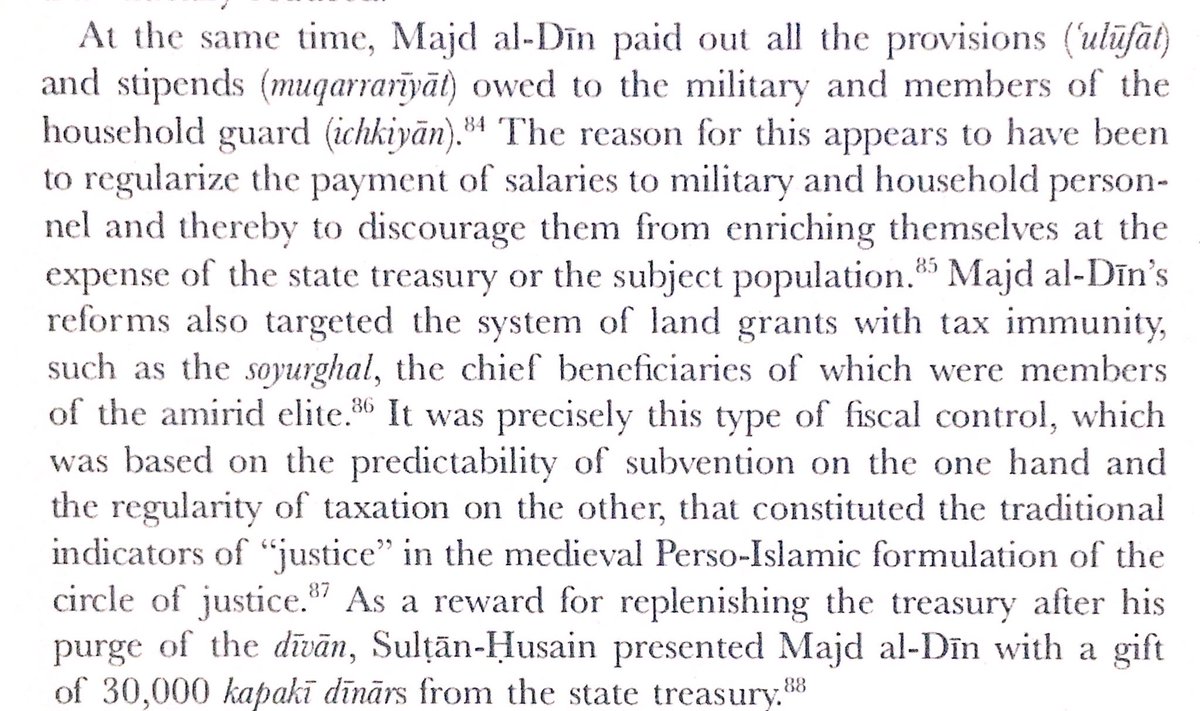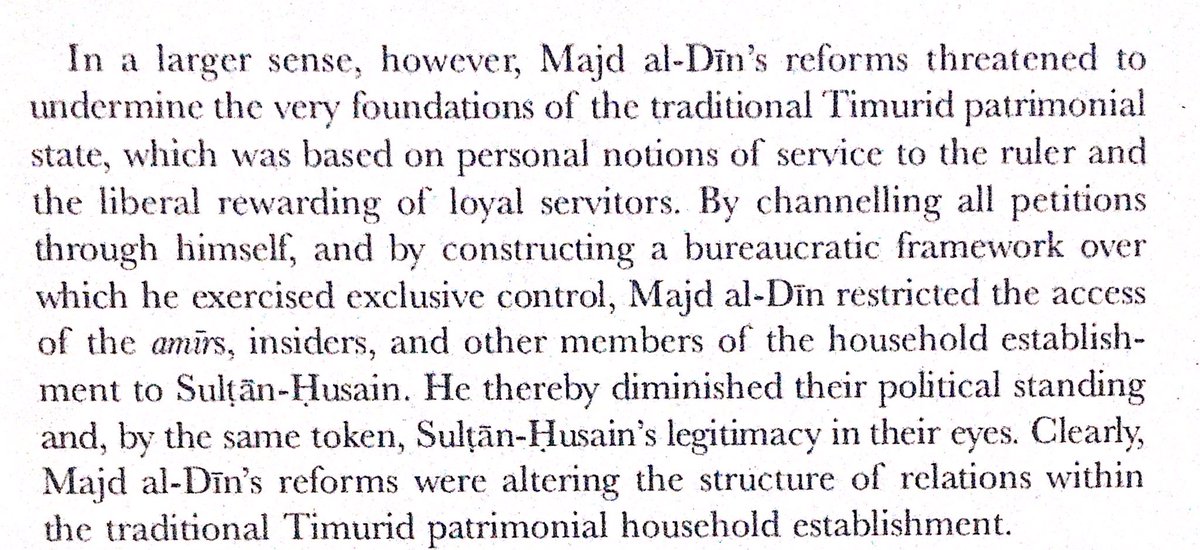Thread with excerpts from "Timurids in Transition: Turko-Persian Politics and Acculturation in Medieval Iran" by Maria Subtelny 

the book focuses on Sultan Husain Bayqara, great-great-grandson of Timur the Lame whose rule comprised a third of the Timurid period en.wikipedia.org/wiki/Sultan_Hu… 

Timur the Lame as half steppe warlord, half Islamic mystic - the “Lord of the Auspicious Conjunction” who dreamed prophecies & read minds. 



Turko-Mongol political & legal customs were very important in the Timurid realms. They were not codified, and separated nomads from sedentary peoples. Timur’s preference for those customs over sharia led him to be considered an infidel by some Islamic thinkers. 







Sharia didn’t become superior to Turko-Mongol customary law in Timurid realms until 1411. Civilizing process was slow, & Islamic education wasn’t expanded until mid-15th century due to threat of Hurufi heresy. Some syncretism was allowed - horsemeat & kumis were deemed halal. 







Timurid Cossacks (Qazaqi) - brigands formed from men who fled to the periphery for whatever reason. Feuding pretenders recruited from them in their campaigns for the throne, & would reward them with power if they won. 







Authoress is right to be skeptical of some of the ancestral claims of Sultan Husain Bayqara. If he was the ninth-generation descendant of an 11th century Sufi saint, then male generation times in that line would be 54 years on average. 



While Herat was overwhelming Hanafi Sunni in 1470s, Turko-Mongols in Khorazm & Khorasan were influenced by Sufis who had taken the role previously held by pagan shamans. The Sufis spread heterodox ideas & mystic practices, some of which were Shia in origin. 





Sultan Husain strictly enforced sharia law after his final capture of Herat. Despite the hypocrisy of his court, the morality police were quite active. 



Sultan Husain’s original Turkic friends, while capable soldiers, were brigands who could only obtain money through plunder - devastating Khorasan. It was Persian bureaucrats from Khaf who would reintroduce orderly accounting, bureaucracy, & finance to the realm. 







Timurids faced the problem that always confronts barbarians establishing settled states: allow nobility broad autonomy & wealth which weaken state finances & force collaborative government - or solidify state authority & secure finances at cost of loyalty of nobility & military. 



Islamic philosophy and institutions offered - at least in the Timurid realms - some moral & legal protection for the peasantry. Excessive taxation & extortion were viewed as un-Islamic. 







Late Timurid thinkers developed their own idea of a mixed constitution - the four social classes of soldiers, bureaucrats, artisans/traders, and peasants needed to be kept in balance like bodily humors. en.m.wikipedia.org/wiki/Mixed_gov… 



Timurids restored water infrastructure in their realms, allowing for population growth in some areas such as Herat. However, warfare between Timur’s successors destroyed Sistan’s dams, depopulating Sistan for at least forty years. 







Islamic inheritance laws are unfavorable to women, but many took advantage of Hanafi legal interpretations that allowed for property (including businesses) to be inalienably endowed to a charity whose beneficiaries could be assigned by the donor. 







About 30% of properties in Herat region towards the end of the 15th century were owned by charitable endowments. 

Corruption in Islamic charities was well-known as far back as the 13th century AD, and differed little from the rampant corruption in USian charities today. 





Islamic jurists had a dim view of visiting graves as either a false imitation of the hajj or outright idolatry, but were largely ignored by the masses from the 9th century on. Shrine pilgrimages were popular in Timurid era. 







Ottoman-Safavid relations were horrible at the time, so Shia Safavids blocked the (still Hanafi Sunni) Central Asian Moslems from making the hajj.
https://twitter.com/peter_nimitz/status/1514080338980454400
Babur noted that the last Timurids had grown soft as their realm was becoming civilized. He was right - the Uzbeks under the Shaybanids invaded Khorasan & destroyed the Timurids in 1507. 

it’s a quick read, well written, & very interesting. I think a lot of you guys would like the book - not just for specifics on 15th century Khorasan but also for cultural convergences in civilizing processes, water management, & political theory.
• • •
Missing some Tweet in this thread? You can try to
force a refresh










































